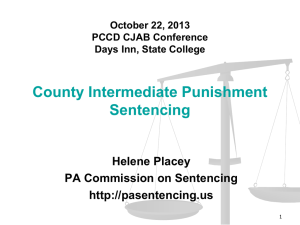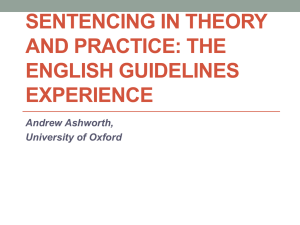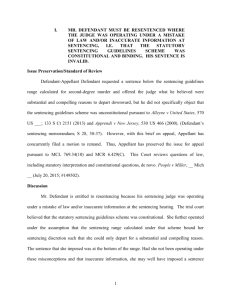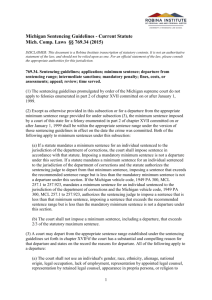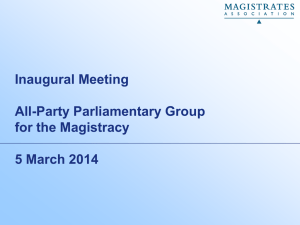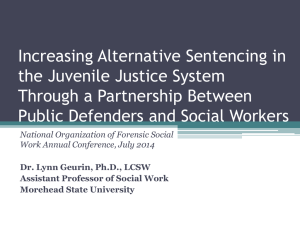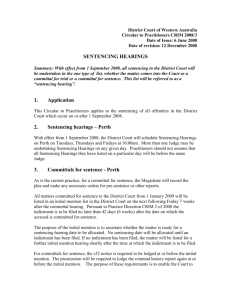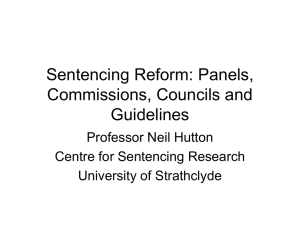Sentencing Guidelines in England and Wales: Lessons for Europe?
advertisement
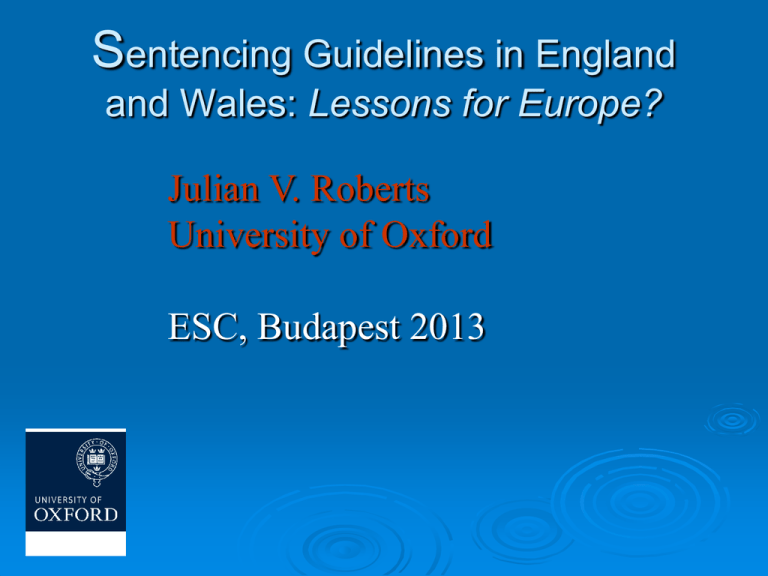
Sentencing Guidelines in England and Wales: Lessons for Europe? Julian V. Roberts University of Oxford ESC, Budapest 2013 Outline: What I want to do • Note the need for a more panEuropean approach to sentencing – Model Sentencing Code? • Discuss the recent English experience and draw some lessons for Europe; • Encourage a European conversation about sentencing, as advocated by Tom O’Malley. 2 Sentencing in Europe 40 years since Council of Europe report on sentencing (1974) 20 years since “Consistency in Sentencing” (R. 92) was adopted (1993). Since then, little systematic progress in the area of sentencing although progress in greater harmonization in other areas of criminal law. Among other reforms, R 92 called for.. Grading offences into levels of seriousness; Sentence ranges (from which courts have the discretion to depart) and Starting point sentences within the ranges; Clarification of the major Agg/ Mit factors; Limits on the aggravating effect of prior convictions; Sentencing statistics capable of revealing sentencing practices and uncovering lack of consistency. Developments in England and Wales Offence-specific guidelines containing a step by step methodology for courts; A system which is prescriptive but flexible (too flexible for some! (eg Ashworth); Generic guidelines affecting issues such as guilty plea reductions; Statutory, independent sentencing authority (Sentencing Council); Twin sources of sentencing data: aggregate annual statistics and a survey derived directly from the sentencer. Overview of Guidelines methodology Step 1: Identify which of (usually) 3 categories of seriousness/ culpability is appropriate; Step 2: Use the Starting point sentence in the selected category to fine-tune a provisional sentence within the range (move up or down to reflect aggravating and mitigating factors). Steps 3-9: Proceed through the remaining steps of the guideline (e.g., reduction for Guilty Plea). 6 7 8 9 10 7 Remaining Steps Consider assistance to the prosecution Reduce sentence for guilty plea Consider dangerousness provisions Apply totality principle for multiple offence cases Consider compensation/ ancillary orders Give reasons (see new provisions in LASPO) Reduce sentence to reflect time in remand Statutory Duty of a Court: Coroners and Justice Act 2009 “Every court must follow any sentencing guidelines which are relevant to the offender's case….unless the court is satisfied that it would be contrary to the interests of justice to do so. …but nothing in this section imposes on the court a separate duty to impose a sentence which is within the category range”. (emphasis added) 12 Example of Ranges: Assault Causing Bodily Harm Category 3 Range: Fine to Community Order; Category 2: Community order to1 year custody; Category 1: 1-3 years custody. Offence Range: Fine- 3 years custody. Statutory Range: Discharge to 5 years custody. 13 Insights into sentencing practices % sentences compliant with the guidelines (high because of great width); Extent of plea-based sentence reductions; Clarification on the role of previous convictions; Quantification of the importance of mitigating and aggravating factors (e.g., remorse). Compliance Rates, Selected Assault Offences, 2011 Offence Assault occasioning actual bodily harm Inflicting grievous bodily harm/ unlawful wounding Causing Grievous Bodily harm/ Unlawful Wounding % of % of % of sentences < sentences sentences > range within range range 1% 97% 2% 0% 97% 3% 7% 92% 1% Clarity, Transparency and Predictability in Sentencing Sentencing provisions in most European jurisdictions lack clarity – a good example is a recent provision regulating sentencing discounts for a guilty plea in Slovenia. In contrast, the English and US schemes provide clear indications of the way that provisions such as guilty plea reductions are applied by the courts. GP reductions, Slovenia The sentence of an offender, who pleads guilty at his first hearing or who pleads guilty after reaching an agreement with the prosecution, may be reduced in accordance with the following: 1) if a prison sentence for a term of 10 or more years is prescribed as the lowest limit for a specific offence, such a limit may be lowered to 3 years of imprisonment; 2) if a prison sentence for a term 3 to 10 years this limit may be lowered to 3 months of imprisonment; 3)if a prison sentence for a term of less than 3 years is prescribed as the lowest limit, such a limit may be lowered to 1 month of imprisonment; 4) if a prison sentence for a term of less than 1 year is prescribed as the lowest limit, a fine may be imposed in place of the prison sentence. Compare these provisions to arrangements in England and Wales (next slide) English Guilty Plea Guideline Recommendations and judicial practice regarding these Conformity with the Guideline in England None 1-10% 11-20% 21-32% 33% or more Expected Sentence Reduction First opportunity <1% <.05% 2% 9% 88% 33% After first opportunity but before trial date <1% 6% 22% 34% 37% 24% On or after day of trial 6% 48% 24% 9% 12% 12% Problems remain in the English scheme.. Failure to constrain prison population – guidelines simply institutionalise current practice; Only modest improvements in consistency; Little attempt to improve the effectiveness of sentencing; A number of statutory duties of Council remain to be fulfilled; Limitations on the Crown Court Survey. But there has been progress… Creation of a permanent, independent statutory authority for sentencing – may protect sentencing from penal populism; Creation of a system capable of reducing prison population by changing judicial practice; Development of comprehensive set of offence-specific, and generic guidelines; Inauguration of first sentencing survey derived directly from sentencers to monitor compliance and provide accurate information about sentencing trends; Creation of a transparent sentencing system; Promotion of a more consistent approach to sentencing? Conclusions There is a need for a pan-European sentencing model, along the lines of the 1993 recommendations. This would promote important sentencing principles and objectives, enhance consistency across the Union. Jurisdictions would be able to implement derogations from the model to accommodate legitimate local variation. At the end of the day, however, fundamental issues such as proportionality are universal. Opposing a more uniform sentencing model is tantamount to opposing universal jurisdiction or the creation of international tribunals such as the ICC. Finally, for more information.. Köszönöm! Thanks for your time and attention! 24


